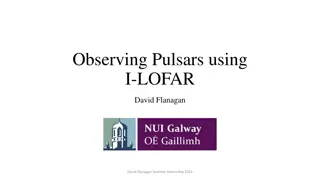Understanding Soft Gamma-Ray Emissions from Pulsar Polar Caps
Soft gamma-ray emissions from the polar cap cascade region are a subject of interest in astrophysics, with studies focusing on the fundamental physical processes of pulsars and potential origins of non-thermal X-ray emissions. Researchers explore the emission processes, polar cap accelerators, casca
0 views • 16 slides
Linking Soft-Ray Pulsar and Fermi LAT Pulsar Populations
This research presentation explores the connection between the soft-ray pulsar population and the Fermi LAT pulsar population, focusing on observational data and methodologies for increasing the sample size to enhance our understanding of high-energy pulsars. The study outlines the identification pr
0 views • 13 slides
Radio Ejection in Accreting Millisecond Pulsars: Evidence and Mechanisms
Investigating the phenomenon of radio ejection in accreting millisecond pulsars, this study explores the mechanisms behind this process and presents evidence from observations and theoretical models. Led by Luciano Burderi and collaborators from the University of Cagliari and University of Palermo,
0 views • 16 slides
Exploring X-Ray Emission from Galaxies by Marat Gilfanov
In this collection of images and discussions from the XMM Workshop 2010, Marat Gilfanov and collaborators delve into the study of X-ray emissions from galaxies. They investigate the properties of galaxies, stellar mass correlations, and the formation and evolution of X-ray binaries. The presentation
0 views • 35 slides
Exploring the Fascinating World of Stars and Stellar Phenomena
Discover the mesmerizing realm of astronomy through a journey into various types of stars, including giant, supergiant, white dwarf, brown dwarf, and neutron stars. Learn about blue giants, red supergiants, white dwarfs, brown dwarfs, neutron stars, and pulsars. Explore the concept of supernovae, th
0 views • 6 slides
Exploring Pulsars with I-LOFAR: David Flanagan Summer Internship 2021
Collapsed remnants of supernovae, pulsars emit electromagnetic radiation from their magnetic poles, observed using I-LOFAR at Birr Castle. Learn about Pulsar B1929+10, I-LOFAR operations, and accessing raw data during the research internship supervised by Dr. Aaron Golden.
0 views • 19 slides
Low-level X-ray Emission of Transitional Pulsars
Delve into the intriguing realm of transitional pulsars emitting low-level X-rays, exploring unique phenomena like pulsations at unprecedentedly low X-ray luminosities, the influence of accretion processes and propeller effects, and potential solutions involving outflows and the location of the magn
0 views • 17 slides
Insights into X-ray Timing and Mass of Accreting Compact Objects
The study explores the variability and high-frequency QPOs of accreting compact objects, providing a unique opportunity to probe effects in strong gravitational fields. It delves into the properties of neutron stars and the explanations for HF QPO phenomenon related to orbital motion in strong gravi
0 views • 20 slides
Impact of Velocity Field Variations on Pulsar Magnetic Fields
The study explores how variations in velocity fields affect pulsar magnetic fields, highlighting the conversion of kinetic energy to magnetic energy in pulsars. Glitches in these systems can lead to changes in magnetic fields, influencing pulsar emissions. The maintenance of stable magnetic fields a
0 views • 14 slides








